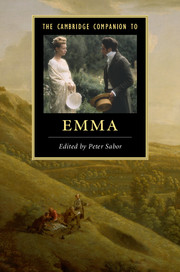Book contents
- The Cambridge Companion to Emma
- The Cambridge Companion to Emma
- Copyright page
- Contents
- Illustrations
- Contributors
- Preface
- Book part
- Glossary
- Chronology
- 1 Composition and publication
- 2 The literary context
- 3 The historical context
- 4 Money and rank
- 5 Contemporary responses
- 6 Style, structure, language
- 7 The heroine
- 8 Setting and community
- 9 Music
- 10 Games, riddles and charades
- 11 Translations
- 12 Screen versions
- Guide to further reading
- Index
- Cambridge Companions to …
- Cambridge Companions to …
- References
Guide to further reading
Published online by Cambridge University Press: 05 September 2015
- The Cambridge Companion to Emma
- The Cambridge Companion to Emma
- Copyright page
- Contents
- Illustrations
- Contributors
- Preface
- Book part
- Glossary
- Chronology
- 1 Composition and publication
- 2 The literary context
- 3 The historical context
- 4 Money and rank
- 5 Contemporary responses
- 6 Style, structure, language
- 7 The heroine
- 8 Setting and community
- 9 Music
- 10 Games, riddles and charades
- 11 Translations
- 12 Screen versions
- Guide to further reading
- Index
- Cambridge Companions to …
- Cambridge Companions to …
- References
Summary

- Type
- Chapter
- Information
- The Cambridge Companion to ‘Emma' , pp. 204 - 210Publisher: Cambridge University PressPrint publication year: 2015

